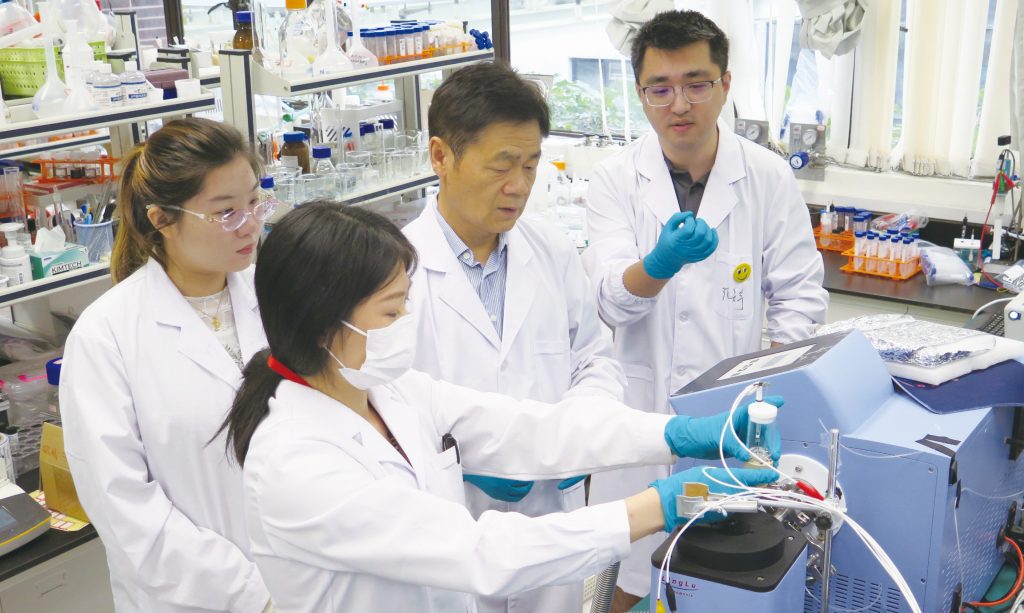November 2023 | Volume 25 No. 1
Everything under the Sun
Listen to this article:
Carbon-heavy methane ranks high on the climate change blacklist, with a global warming potential that is more than 80 times that of carbon dioxide over a period of 20 years. It is also in abundant supply – the recent global increase in methane (CH4) is primarily attributed to the shale gas revolution – and is useful for thermal power generation.
However, to mitigate its harmful effects while at the same time offering environmental benefits, scientists have been working on ways to achieve direct CH4 conversion into value-added chemicals such as methanol, formaldehyde and formic acid – thereby creating considerable economic advantages too.
Professor Zhengxiao Guo from the Department of Chemistry and Professor Junwang Tang, now at Tsinghua University’s Department of Chemical Engineering, have taken a major step towards achieving this with the development of a highly active catalytic material that can efficiently convert methane into an essential chemical in a waste-free manner.
Professor Guo said: “Converting methane into other chemicals is a tremendous opportunity to achieve net-zero energy. One of the challenges though, is that methane is an extremely stable molecule and very resistant to activation, particularly under mild or ambient conditions. Thus, achieving high activity and selectivity in catalytic methane conversion has long been considered by chemists to be a significant challenge.”
Catalytic material
The team’s innovative catalytic material is derived from tungsten trioxide (WO3 catalyst) and features a dual active site comprising copper and tungsten atomic species that work in tandem to ensure an effective and selective conversion process. Tungsten trioxide nanocrystals were used as the substrate due to their visible-light responsive property.
Hence, the conversion process is achieved highly selectively using visible light, meaning there are no unwanted by-products and ensuring it is an eco-friendly alternative to current production methods. “Current production of formaldehyde involves methanol oxidation or dehydrogenation, above 250-700 degrees Celsius, and consumes a considerable amount of energy,” said Professor Guo.
The new process exhibited nearly 100 per cent selectivity and high conversion efficiency, significantly outperforming previously reported photocatalysts. The findings have been published in the prestigious journal Nature Communications.
“Key to realising such direct conversion and selectivity is the regulation of the reactive oxygen species (ROS), enhancing the conversion of methane and promoting desorption of the desired products, whilst suppressing its mineralisation to CO2. This is like creating an electronic conduit for the value-added chemical to be produced, rather than letting the whole process run completely downhill,” said Professor Guo.
“Mechanistic analysis revealed that copper helped move electrons around and create reactive molecular species, while the tungsten helped activate the methane gas. The copper acted as electron acceptors and promoted photo-induced electron transfer from the conduction band to dioxygen, generating reactive hydroperoxyl radicals.”
At the same time, the adjacent tungsten atom that had a partial positive charge facilitated ‘hole’ transfer, as effective electron-hole separation is critically important for efficiency. The preferred adsorption and activation site of water produced reactive hydroxyl radicals and effectively activated methane to methyl radicals. The synergy of the adjacent dual active sites boosts the overall efficiency and selectivity of the conversion process.
Solar power
“It is highly desirable to turn methane into low-carbon and high-value-added chemical products, using abundant solar power,” said Professor Guo. “However, product selectivity and production efficiency are key to success. Here, we have achieved very high selectivity, but the efficiency can still be improved to make the process more practically viable.
“This requires in-depth understanding of the photo-electronic behaviours that govern the conversion process and further engineering of the catalyst system. Interestingly, those two tasks may benefit from the advanced technologies that underpin the two recent Nobel Prizes in Physics and Chemistry, respectively: the use of attosecond spectroscopy to probe photo-electronic behaviours and the application of quantum dots to promote the overall electron transfer efficiency. Those are indeed some of the focussed directions of our multidisciplinary consortium, currently funded by the UGC Theme-based Research Scheme.”
This is not the first time that Professor Guo has successfully ‘harnessed the sun’ to effect transformation. Last year, working with another research team, he developed a process to catalyse net-zero green hydrogen from the sun using a fundamental catalyst protonation process to promote solar-driven hydrogen generation from water, without any CO2 emissions.

Professor Guo (second from right) and his research team working on photocatalysis in the laboratory.
Converting methane into other chemicals is a tremendous opportunity to achieve net-zero energy. One of the challenges though, is that methane is an extremely stable molecule and very resistant to activation, particularly under mild or ambient conditions.

PROFESSOR ZHENGXIAO GUO

